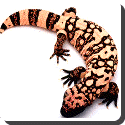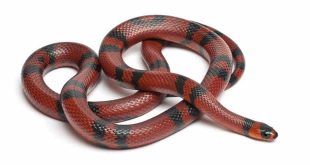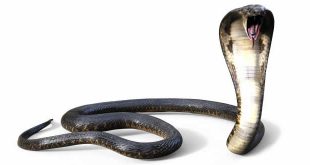 Gila Monster — The Gila Monster, Heloderma suspectum, is a species of venomous lizard native to the southwestern United States and northern Mexico. It is a heavy, slow moving lizard, up to 60 cm (2 feet) long, and is the most venomous lizard native to the USA. Its skin has the appearance of black, pink, orange, and yellow beads, laid down in intricate patterns. These beads are small bony plates that form scales, and are known as osteoderms. Until very recently, it was thought to be one of only two species of venomous lizard, the other being its close relative the Mexican beaded lizard. However research at the University of Melbourne, Australia and Pennsylvania State University has revealed that in fact many lizards in the iguanian and monitor families have venom-producing glands.
Gila Monster — The Gila Monster, Heloderma suspectum, is a species of venomous lizard native to the southwestern United States and northern Mexico. It is a heavy, slow moving lizard, up to 60 cm (2 feet) long, and is the most venomous lizard native to the USA. Its skin has the appearance of black, pink, orange, and yellow beads, laid down in intricate patterns. These beads are small bony plates that form scales, and are known as osteoderms. Until very recently, it was thought to be one of only two species of venomous lizard, the other being its close relative the Mexican beaded lizard. However research at the University of Melbourne, Australia and Pennsylvania State University has revealed that in fact many lizards in the iguanian and monitor families have venom-producing glands.
The name “Gila monster” refers to the Gila River Basin in Arizona. The generic name for Heloderma is from the Greek words Helos coming from the head of a nail or stud, and derma for skin, therefore Heloderma means studded skin. Suspectum comes from Cope’s notion that the lizard might be venomous due to the grooves in the teeth.
Unlike snakes which use hollow upper teeth (fangs), the Gila monster injects venom into its victim through grooves in the teeth of its lower jaw. The teeth are loosely anchored, which allows them to be broken off and replaced throughout their lives. The Gila monster produces only small quantities of its neurotoxic venom, which is secreted into the lizard’s saliva. By chewing its prey, however, it tries to put as much of the venom into the bloodstream of its victim as possible. The Gila monster’s bite is normally not fatal to humans (there are no confirmed reports of fatalities), but it can bite quickly and holds on tenaciously. When Gila Monsters bite, they hold on tightly and chew. This helps them work their venom into the bite. Gila Monster bites are not deadly, but it is important to see a doctor if bitten.
Gila monsters live from southwest Utah to the southern Sonora and northern Sinaloa; extreme southwest New Mexico to southern Nevada and just into eastern California. Heloderma suspectum also occurs up to an elevation of 4,800 feet. The Gila monster is more common in the wetter, rockier paloverde-saguaro desert scrub association than the drier, sandier creosote bush-bersage association. Heloderma suspectum also seem to prefer rocky foothills and avoid open areas and agricultural regions. Gila monsters live in burrows dug by other animals or may construct their own.
The Gila monster’s diet generally consists of small rodents, juvenile birds as well as eggs of both birds and reptiles and every so often another reptile. The Gila monster eats large meals infrequently and can consume a meal of one third of its body weight. Young Gila monsters are known to be able to consume up to 50% of their body weight. An adult Gila monster can consume its entire yearly energy budget in three or four meals.
 Kids Portal For Parents India Kids Network
Kids Portal For Parents India Kids Network


